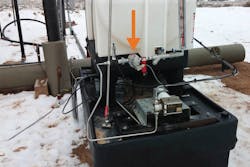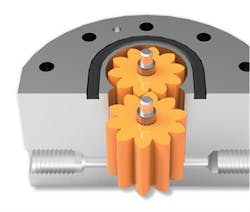Many companies in the oil and gas industry still entrust chemical dispensing with a time-controlled output to process timers. Timers primarily serve as independent switches that open and close valves, pumps and other gateways to dispense liquids during specific intervals across an allotted amount of time. While a timer can provide a time-controlled output that is carefully configured to equal a certain quantity, it cannot verify if anything is flowing through process channels. In fact, a timer will continue to operate even if nothing enters a pipeline or if flow stops entirely due to an obstruction or problem. And a timer cannot determine if chemicals reach their final destination.
Say, for example, an oil patch uses timers to open and close valves for five minutes every hour on a continuous basis in dispensing chemicals from a storage tank through a pipeline to a well as part of a chemical injection process. If the pipeline has a clog or leak, the timer will continue to operate as if nothing is wrong. As a result, chemicals enter the well at an undesirable flow rate or not at all. As the chemicals used in oil wells can be expensive, any leak could be costly. For example, if a 55-gallon drum costing $5,000 is calculated to last for a month, over dispensing by 15 percent in that month would result in a loss of $750 per month, or $9,000 annually. Without the proper amounts of additives entering the well, crude oil also would not be adequately processed, ultimately resulting in scaling and blockage that would stall production. Adding too much chemical could over-treat crude oil, leading to an inferior product.
When first used in the oil and gas industry, timers were manually controlled, requiring operators to open and close valves. Time lags in operator intervention caused inaccurate chemical dispensing. Today, even as timers operate more accurately as part of pneumatic or electronic systems, they essentially serve as switches that turn devices off and on. Even when configured as part of a programmable logic control (PLC) system, timers can only provide the status of valve positioning and never feedback of flow rate or total.
As companies look to contain costs while addressing tighter process requirements, flowmeters are an attractive alternative to timers. Eliminating timer limitations, flowmeters continuously monitor flow rates to ensure the right additive amounts enter a well. Instead of leaving to chance that fluid is flowing through a pipe or duct, flowmeters can serve as alarms to signal when liquid is not flowing to preset limits. In fact, in an automated control system, a sensor mounted on a flowmeter can signal a PLC to either increase or decrease pump revolutions per minute or fine tune a fluid regulator if chemicals are not flowing to specifications. The loss of a flowmeter signal could also sound an alarm or shut down the entire system.
Certain flowmeters measure the totalized amount of fluid that passes through them, displaying flow in units such as gallons per minute. Serving as part of a closed-loop system, flowmeters can track flow rates and can send output to a PLC where it is recorded to determine the amount of chemical that flowed over a period of time, whether one day, one month or a year. Information can be used to determine chemical costs and usage as well as address U.S. Environmental Protection Agency regulations.
Different technologies of flowmeters
Different flowmeter technologies are available on the market. Positive displacement meters (see Image 1) are the industry standard for chemical injection. Offering excellent resolution flow measurement with high pulses per gallon, they provide greater flow assurance and superior accuracy with high turndown, even at very low flow rates.
The principle of operation of these volumetric flow measurement instruments is based on fluids driving the gears. A non-intrusive sensor detects gear movement. As each gear tooth passes the sensor (see Figure 1), a square wave pulse is produced, and a discrete volume of liquid is measured. The resulting pulse train is proportional to the actual flow rate and provides a highly accurate representation of the fluid flow.
Figure 1. This drawing depicts the gears of a positive displacement flowmeter, showing the direction of flow through the meter. Each time a tooth of the gear passes the sensor, it is counted. Because the void between the teeth carries a discrete amount of liquid, flow is measured in subtle amounts during the cycle.
Positive displacement flowmeters come in various configurations — including spur gear meters, which are ideal for measuring non-abrasive, low- to medium- viscosity fluids; helical gear meters, designed for higher viscosities; and rotary pistons, which accommodate ultra-low flows as well as high pressures.
In addition to positive displacement meters, Coriolis mass flowmeters are becoming a popular choice for chemical injection applications as well as gas measurement processes such as engine test benches, hydrogen fuel stations and high-pressure gas measurement in numerous other industries. Other flowmeter technologies, including turbine, thermal mass and variable area, can be used beyond the chemical/petrochemical industry to perform in automotive plants for monitoring paints, coatings, lubricants and other fluids to manage operation costs and stay in compliance with regulations. In hydraulics/ fluid-power systems, flowmeters monitor flow readings, diagnosing system errors and ensuring pump performance. They are also ideal for batching industrial process control and hydraulic monitoring applications.
With all the different flowmeter technologies available on the market, choosing the right one can be difficult. While it seems reasonable that unit cost and specifications should drive selection, when choosing the right flowmeter, technology, application, fluid viscosity, installation costs and environment conditions should be considered important factors. Lack of expertise in the parameters and effects of a flow application or the differences in flowmeter technology (as each offer different advantages) can lead to a poor selection that affects both the process and operating costs. Because no standardized chart or easy-to-follow selection methodology exists for choosing the right meter, companies should consult a flow measurement authority or expert since many system and fluid properties affect the suitability of a particular meter type. With a properly specified flowmeter, companies will gain greater control of processes through more detailed and regular system status feedback, enhancing system efficiency and overall production.
Robert Childs has a broad range of field knowledge and experience in onshore and offshore applications. Having worked at AW-Lake Company for 14 years in technical sales and support roles, he currently serves as applications engineer, providing flow measurement engineering solutions to customers in North, South and Central America. AW-Lake is a North American design, manufacturing and service company of flow measurement technology for the fluid control needs of various industries.
AW-Lake Company


